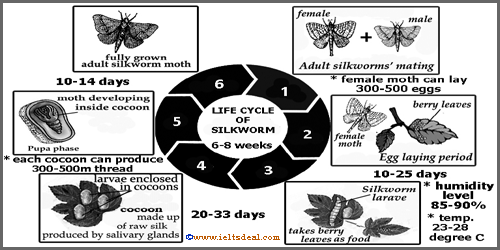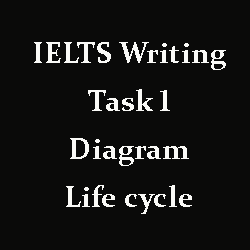IELTS Writing Task 1: Diagram, life cycle of a silkworm moth
In this post of IELTS Writing task 1 for the academic module, a cycle diagram will be discussed. It is a common type of diagram which many students find confusing and difficult to write. This cycle diagram is a presentation of the life cycle of silkworm moth. As you know, life cycle means a continuous process, it requires clear attention on the part of a student to write the most important details of the diagram. If you fail to gather the idea of the picture, you might lose important points which can result in a penalty.

First, let’s have a look at the title and the picture and think about it for 2 minutes.
The diagram shows the life cycle of the silkworm moth.

As you can see that there are some important points to note in this diagram.
- It has a total of six stages.
- It is a continuous process.
- Every picture has some notes on it.
- There are a few notes outside the pictures too.
- Some important things are mentioned using a star sign.
- We have to write a minimum of 150 words for this.
Considering these points, we have to present a report on the picture. You cannot include your own opinion, reasons, effects, and logic in your writing. It is mandatory to write at least 150 words but the maximum range is not indicated.
It is, in my opinion, better for you to make a short note on the question paper with a pencil. This also helps you to write your answers in an organized way. You can include some sequential connectors/ connecting words. This will help the examiner follow the writing easily and you will surely get a great band.
The model answer I wrote for this picture contains some significant vocabulary and sentence patterns which are helpful to achieve a higher band. So, it is my request to you to copy the answer with a pencil from this post and read it twice or thrice. Thus, you will be habituated and find it easy to write the answer to a diagram.
Model answer:
The displayed illustration is a detailed presentation of the life cycle of the silkworm.
It is apparent that there are six stages in the life cycle of the silkworm which takes 6-8 weeks to complete.
As can be seen, the life cycle of a silkworm begins with the mating between male and female moths. Then, the mother moth spawns eggs on berry leaves. A moth can lay from 300 up to 500 eggs. Subsequently, the silkworm larvae are hatched after 10-25 days in the third stage. The condition for the hatching requires a humidity level of 85-90% and 23 to 28-degree Celsius temperature. The silkworm larvae usually feed on the berry leaves.
After 20-33 days the fourth stage begins where the larvae get enclosed in a small oval-shaped room known as a cocoon. It is made up of raw silk that is produced by the salivary glands of the larvae. Here, each larva stays in a single cocoon for 10-14 days and completes the stage known as the pupa phase. Each of these cocoons can produce a 300-500m long thread. Finally, after 10-14 days adult moth gets out of the cocoon and thus the whole process continues.
(196 words)
That is the end of the answer.
Here are some other diagrams that you can practice:
Flow-chart on sweater manufacturing
Process diagram on olive oil production
Two maps showing changes in an industrial village
Two maps showing changes in a town
Life cycle diagram on tuna fish
Cycle diagram on water movement




10 thoughts on “IELTS Writing Task 1: Diagram, life cycle of a silkworm moth”